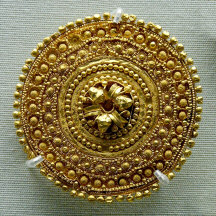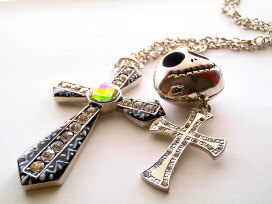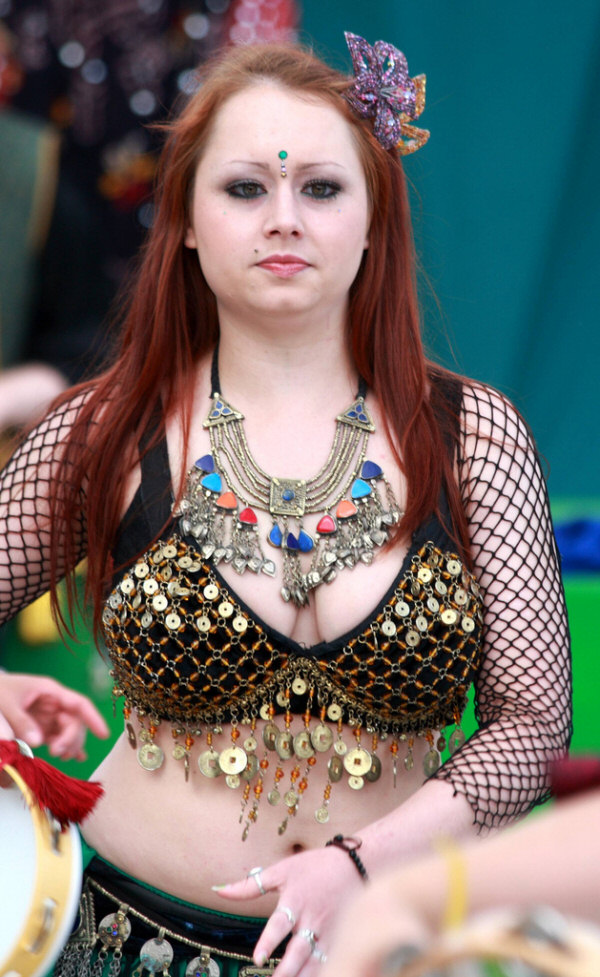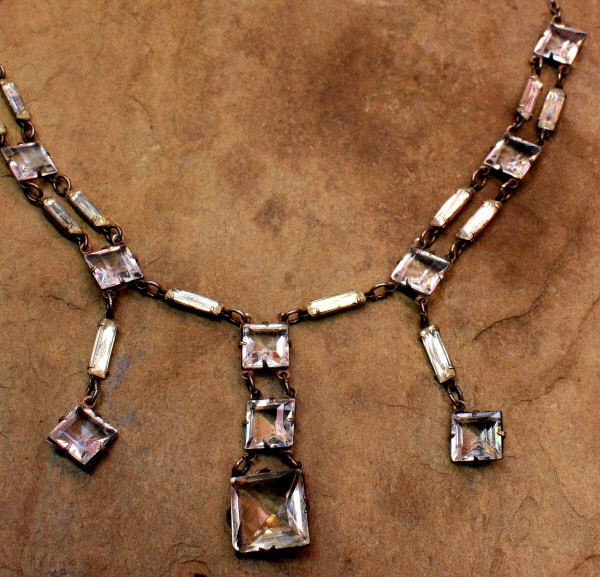Jewelry Through the Ages
Looking Back at its Origin
 Jewels have evolved as much as humans did. Playing its part in many ancient
cultures, jewelry were made from stones, bones, shells, animal skin or feathers
to decorate the bodies of humans who lived about 100 000 years ago. As people
and civilizations spread, inventions and advancement of technology were
accompanied by the discovery of materials that can be shaped into precious
adornments. Metals and gems came into great importance as they served as status
symbols in many cultures. Artisans also came up with exquisite jewelry designs
both men and women loved. Despite the development in gemology and metallurgy,
jewelry’s purpose seems to be constant- a way to express one’s love for precious
things, rank, religion, wealth, and even love for someone. With the role it
plays in the level of the elites and royalties, it became a subject of continual
refinement. Jewels have evolved as much as humans did. Playing its part in many ancient
cultures, jewelry were made from stones, bones, shells, animal skin or feathers
to decorate the bodies of humans who lived about 100 000 years ago. As people
and civilizations spread, inventions and advancement of technology were
accompanied by the discovery of materials that can be shaped into precious
adornments. Metals and gems came into great importance as they served as status
symbols in many cultures. Artisans also came up with exquisite jewelry designs
both men and women loved. Despite the development in gemology and metallurgy,
jewelry’s purpose seems to be constant- a way to express one’s love for precious
things, rank, religion, wealth, and even love for someone. With the role it
plays in the level of the elites and royalties, it became a subject of continual
refinement.
The Notable Stages of Development
Before jewelry was considered a timeless beauty, it has developed through
important stages. It was presented and perfected across the ancient
civilizations of Egypt, China and India. Jewelry and the standards for its
beauty were established in Mesopotamia and Egypt. Ancient metal artists in these
areas have introduced practices in gem collection, metallurgical standards and
glass manufacturing and carving. The tradition on jewelry and their designs that
started on these parts of the world became accepted standards that reached and
influenced the popular European jewelry craftsmanship. Despite the limited
resources for perfecting the decorative pieces, unique styles from Egypt and
Mesopotamia continue to lure people even after thousands of years.
Having their civilizations developed early on, China also became an important
driving force in the development of gemology and designs in Asia. Its unique
pieces inspired by nature, animals and the mystical dragon gain popularity and
spread across the continent. With their trade and contact with neighboring
territories, jewelry and the prestige they bring has formed in cultures
surrounding the Chinese dynasties.
Indians on the other hand successfully established jewelry as part of their
social classes and religious life. Because they have been early on their
discovery and utilization of precious minerals like gold, they are way ahead in
the craft compared to any other countries in the area. Their art of
jewelry-making made the country one of the most sought-after places in the
earlier times. Trade and, eventually, colonization have influenced the
widespread popularity of the craft even across powerful Europe.
Evolution of Jewelry
As a symbol of social status, wealth, and beauty, jewelry has been popular
across races, cultures and religions. This well-known form of self-expression
seems to continue the tradition set forth by famous artisans of the earlier
centuries. From the bead bracelets to shell necklaces, people from many
civilizations used them as charms. It can even be noted that many still fancy
these designs in the present day. Earrings that dangle and rings used as symbols
of a promise even continue to serve the same purpose today as they did about
4000 BC. With the revolutions in social and economic conditions, jewelry evolved
over time. What used to be a form of money or currency in the past has now
evolved into accessory or expensive adornment. In many traditional cultures,
using precious pieces of jewelry for barter or purchase is still practiced.
Expensive jewelry is used as basis for a country’s wealth and many personally
consider gems and gold as expensive personal assets. Jewelry pieces like
brooches, pins and buckles that were originally used as symbols of one’s status
are now being utilized more for its decorative purpose. Almost all throughout
the centuries, jewelry remained to play its part as an expression or symbol of
one’s rank in many of the worlds’ religions.
Jewelry’s Role in Cultures and Civilizations
Egyptian
 What has started in one of the world’s earliest civilization was considered the
onset of modern jewelry. With many artisans and craftsmen devoted to designing
and producing decorative metal and gems for their rulers, jewelry making became
a profession paving way to new techniques and skills that made the artistic
pieces must-have materials for people of rank. While its main purpose was to
decorate the body of women, it is mostly used as amulets and talismans by men,
especially the warriors and members of the house of Pharaohs. Back then, colors
and metallic qualities are of top priorities. Gold became widespread and a
favorite metal to work on as it is malleable and abundant. Even the most coveted
diamonds of today were not mainly utilized and loved as it lacks color other
semi-precious stones possess. It is an Egyptian belief that colors attract
certain types of powers transmitted to the wearer. One of the most popular
designs which is perfectly Egyptian is the scarab brooch or pendant. Considered
to be the earthy symbol of heavenly cycle by which the sun god Ra rolls across
the sky to transform bodies and souls, it is often used as amulet. What has started in one of the world’s earliest civilization was considered the
onset of modern jewelry. With many artisans and craftsmen devoted to designing
and producing decorative metal and gems for their rulers, jewelry making became
a profession paving way to new techniques and skills that made the artistic
pieces must-have materials for people of rank. While its main purpose was to
decorate the body of women, it is mostly used as amulets and talismans by men,
especially the warriors and members of the house of Pharaohs. Back then, colors
and metallic qualities are of top priorities. Gold became widespread and a
favorite metal to work on as it is malleable and abundant. Even the most coveted
diamonds of today were not mainly utilized and loved as it lacks color other
semi-precious stones possess. It is an Egyptian belief that colors attract
certain types of powers transmitted to the wearer. One of the most popular
designs which is perfectly Egyptian is the scarab brooch or pendant. Considered
to be the earthy symbol of heavenly cycle by which the sun god Ra rolls across
the sky to transform bodies and souls, it is often used as amulet.
Greece and Roman
 The Hellenic jewelry was known to be a product of trade with neighboring
civilizations and thus vary in style, form and materials. Most pieces made and
worn during this period were for used to symbolize cultural identity or
affiliations. Mostly patterned after godly inspirations, jewelry from Greece and
Rome are intricate. Jewelry designs from these empires have started the fame of
adornments that are delicately crafted from pieces of gold or other metals of
importance. Quite different from other earlier civilizations, Hellenic jewelry
were never assigned special mystic powers. Precious stones were also the main
material utilized for jewelry production. The most popular type of jewelry from
this civilization is the cameo, a portrait of a god, goddess, or famous
individual or leader carved in a stone. During the rise of the Roman Empire,
only cameos of Alexander the Great are made available and craftsmen were ordered
to make highly detailed designs for these. Cameos continue to enjoy the
popularity as it has been modified over certain periods of time. The Hellenic jewelry was known to be a product of trade with neighboring
civilizations and thus vary in style, form and materials. Most pieces made and
worn during this period were for used to symbolize cultural identity or
affiliations. Mostly patterned after godly inspirations, jewelry from Greece and
Rome are intricate. Jewelry designs from these empires have started the fame of
adornments that are delicately crafted from pieces of gold or other metals of
importance. Quite different from other earlier civilizations, Hellenic jewelry
were never assigned special mystic powers. Precious stones were also the main
material utilized for jewelry production. The most popular type of jewelry from
this civilization is the cameo, a portrait of a god, goddess, or famous
individual or leader carved in a stone. During the rise of the Roman Empire,
only cameos of Alexander the Great are made available and craftsmen were ordered
to make highly detailed designs for these. Cameos continue to enjoy the
popularity as it has been modified over certain periods of time.
Christian
 As crusades became successful in spreading Christianity, cultural styles became
quite similar to each other. Most jewelry pieces produced at this period were a
form of symbolism for the Christian faith. In fact, during the earliest period
of the religion, jewelry was produced by monasteries. In order to find funds to
support the causes and expenses of the church, monks were trained for
craftsmanship and were able to produce great quantities of exquisite designs.
Associations that oversee and ensure the quality of jewelry came into being and
inspections on workshops started. The dawn of economic development and the
increase in populace able to afford such a luxury paved way in the increase of
fake or low quality jewelry that threatened the booming industry started by the
monasteries. With Christianity unable to find its way to Celtic cultures, unique
designs exclusive in the population suddenly gained fame and developed quickly.
Because there are no written records of the Celtic, there was very little
information as to the symbolism of their intricate crafts. Precious stones and
metals were the honored materials loved by the wealthy. As crusades became successful in spreading Christianity, cultural styles became
quite similar to each other. Most jewelry pieces produced at this period were a
form of symbolism for the Christian faith. In fact, during the earliest period
of the religion, jewelry was produced by monasteries. In order to find funds to
support the causes and expenses of the church, monks were trained for
craftsmanship and were able to produce great quantities of exquisite designs.
Associations that oversee and ensure the quality of jewelry came into being and
inspections on workshops started. The dawn of economic development and the
increase in populace able to afford such a luxury paved way in the increase of
fake or low quality jewelry that threatened the booming industry started by the
monasteries. With Christianity unable to find its way to Celtic cultures, unique
designs exclusive in the population suddenly gained fame and developed quickly.
Because there are no written records of the Celtic, there was very little
information as to the symbolism of their intricate crafts. Precious stones and
metals were the honored materials loved by the wealthy.
Renaissance
It is during this period when jewelry found its new purpose. Known as the Jewel
Age, it is during this time when metal ornaments were used as symbols of
affluence, culture, and religious affiliations. What used to be amulets or
symbols of belongingness to clans were now used solely as an adornment believed
to improve beauty and personality. Increasingly, many wealthy individuals have
accrued jewelry to preserve status and property. It was also used as currency,
being easily accepted in trade and universally valued in many cultures. With the
shift of role, jewelry, in order enhance beauty, must be made from precious gems
with attractive colors, luster and shine. The belief that they attract and keep
mystic powers was also almost eliminated. After centuries of being neglected,
diamond has finally gained its part on this luxurious business. Cutting methods,
tools and shapers were also developed to cater to the increasing needs and
preferences. The discovery of new lands also resulted in the exploitation of
many gems that are previously considered scarce. Popular pieces that have
survived even today were mostly commissioned by the Royals from France and
England.
Typical modern day Renaissance jewelry:

Early Modern Period
The rapid increase in economic status and the renewed social practices and
strata made jewelry available to both the rich and the lower classes. Diamond
and its popularity continued to soar and machines to produces great cuts were
invented one after the other. The introduction to mass production of jewelry has
destroyed the century-old traditions of handmade crafts. The massive spread in
the popularity of this adornments paved way into the introduction of new
materials previously neglected or frowned upon. Colorful metal and gem designs
including animals and flowers were introduced. This new technique inspired the
20th century glass manufacturing practices. The spread of industries and the
influx of many inventions have changed the trends in gemology and jewelry
making. Popular designs from this period that are loved even today include Art
Deco, Retro and Art Nouveau.
Antique Art Deco Necklace:

Today
Expensive jewelry today is seen as a form of artistic creations made delicately
from materials that are difficult to acquire. Alternately, the discovery of
materials and ways to make affordable adornments made jewelry even more
affordable. Everyone seems to be enjoying the popularity and availability of
these jewels as they are no longer considered exclusive to people of affluence
and rank. In fact, with the technological advancement and the utilization of
synthetic and readily available materials, even the most expensive piece of
jewelry can be duplicated in a matter of minutes. Jewelry making today focuses
more on the display of creativity, design and meaning rather than being symbols
of social class or wealth. The society’s distaste for social classes and
cultural exclusivity enable craftsmen to produce adornments with variety of
styles.

Final Sparkling Thoughts
Adornments and decorations have been used for many different purposes and have
undergone changes all throughout the years. Evolving as quickly as human
civilizations do, jewelry is generally acceptable in almost any culture and
periods of time. Materials used to make these expensive adornments also shifted
from colorful and expensive to varied and affordable. Additionally, what was
exclusively used to exhibit social class is now being enjoyed by all as a form
of self-expression and decorations. With all the transformations jewelry has
been through, it seems to serve some things constantly- expression of
belongingness, love, religious affiliations and beauty. As an ever changing
industry, there is no doubt that designs of great importance are still to be
revived and refined as years go by.
Jewelry
15 Remarkable Facts About Diamonds
Charm Bracelets: Origin and Design Meanings
Jewelry Through the Ages
|